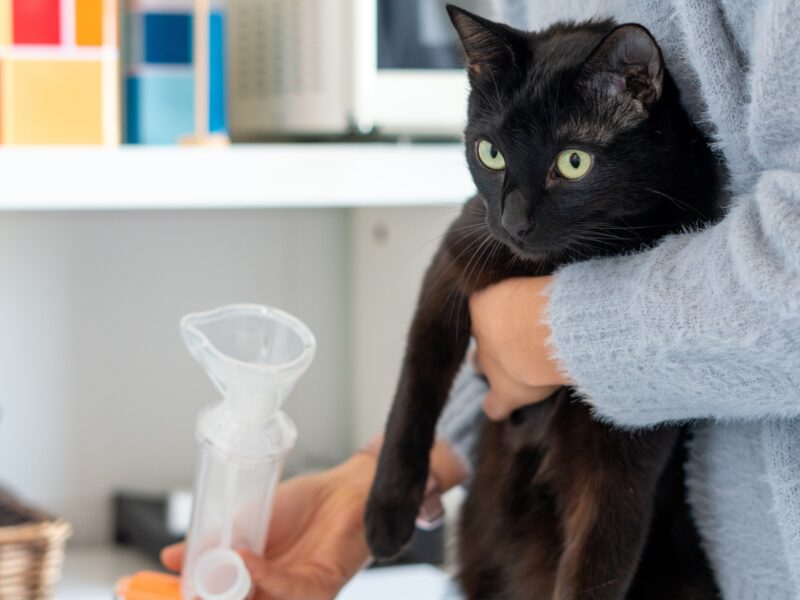
It’s almost springtime in Texas, which means snakes are beginning to slither away from their comfortable winter surroundings and are on the move.
Dr. Jill Heatley, associate professor of veterinary medicine at the Texas A&M College of Veterinary Medicine & Biomedical Sciences (CVM), said active snakes could mean bad news for people and their pets. Heatley and veterinarians in the Small Animal Hospital at the CVM are expecting to see an increase in snakebite cases.
“If you believe your pet has been bitten by a snake, you need to seek veterinary care and the doctor can determine what kind of treatment is necessary,” Heatley explains.
Adds Christine Rutter, a veterinarian in Small Animal Clinical Services, “We have already seen snakebites in dogs this year. One pet required significant care after being bitten by a coral snake, but is thankfully going to be fine. Coral snake bites (and rattlesnake bites) are thankfully uncommon, but are life-threatening when they occur. Copperhead and cottonmouth bites are extremely common during the summer, as are bites from grumpy non-venomous snakes.”
A snakebite on a human can be painful — and also expensive. It is not uncommon for a person bit by a venomous snake to have hospital bills up to $50,000. Hospital treatments can range from one day to several weeks, and include care for damaged tissues and antivenom treatments that can run into the thousands of dollars, according to Heatley.
Although snakes are found in most parts of the world — Ireland, Iceland and New Zealand are some of the few snake-free countries — only four types of snakes found in Texas are venomous: the coral snake, copperhead, rattlesnake and cottonmouth (also called water moccasin).
“The thing to remember about snakes is that they generally want to be left alone,” Heatley says. “They are probably more afraid of you than you are of them.
“Of the four types of venomous snakes in Texas, the coral, copperhead, and rattlesnake are almost never aggressive unless they are provoked,” Heatley adds. “The cottonmouth has been known to be a little on the aggressive side, so you should be a little more wary of it, especially if you are near a creek or lake where they are frequently seen.”
Heatley says an inquisitive pet could also be a snakebite victim. If bitten, a dog usually suffers the bite on its face or nose, while cats tend to be nicked on their paws.
“The area that has been bitten will usually begin to swell almost immediately, which is a tell-tale sign of a snake bite,” Heatley notes. Venom can spread quickly inside the animal, potentially resulting in kidney failure within 12 to 24 hours.
Notes Rutter, “I would add that weakness, collapse, blood clotting disorders and neurologic changes are also of immediate concern. In the emergency department, veterinarians will be immediately evaluating cardiovascular stability, neurologic status, pain level, blood cell counts, organ function and blood clotting before deciding on the best course of action.”
It is important to know that not all snakebites are the same. “Sometimes an animal or person will get just a small amount of venom from a bite, and sometimes it’s much more,” Heatley says. “There is also such a thing as a ‘dry bite’ in which no venom is injected at all. Interestingly enough, larger snakes tend to have lesser amounts of venom than smaller ones.”
Although many of us may be fearful of snakes, snakes do have a useful purpose — they control the rodent, lizard and even bug populations.
“One of the questions we often get in the veterinary hospital is, ‘How can you tell a venomous snake from a harmless one?’” Heatley said. “The answer is that it is difficult because there are numerous types of snakes that are not venomous that look very similar to a venomous one.” Heatley suggests looking for a triangular-shaped head in identifying poisonous snakes but does not encourage getting too close.
Another frequently asked question in the Small Animal Hospital is how to keep snakes away. Heatley explains that most chemicals tested to do this are also quite toxic to pets and people. “It is better to be mindful of our surroundings, especially in places with pets and children. Try to create an open habitat, which will be less attractive to snakes,” she says.
“When cleaning up brush and leaf piles, it’s a great idea to wear closed toed boots, heavy pants and garden gloves for protection against snake bites,” Heatley adds.
Says Rutter, “While we don’t want an owner to put themselves at any risk, having a photo of the offending snake is always helpful for the ER clinicians to help us determine the appropriate treatment and diagnostics for each patient. We rely heavily on Dr. Heatley and her team to help us be sure we can tell the venomous bites from the pretenders.”
For more information, Heatley and Rutter suggests the Texas Parks and Wildlife website.
###
Media contact: Keith Randall, News & Information Services, at (979) 845-4644 or Jill Heatley at (979) 845-1202 or Christine Rutter at (979) 845-2351 or crutter@cvm.tamu.edu



